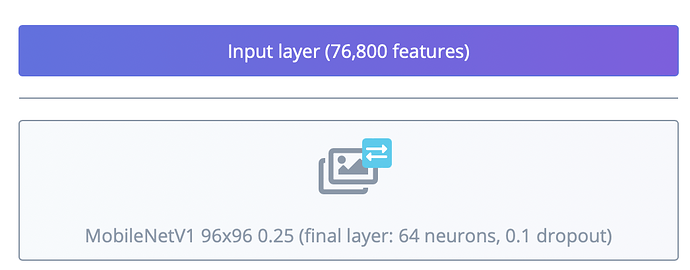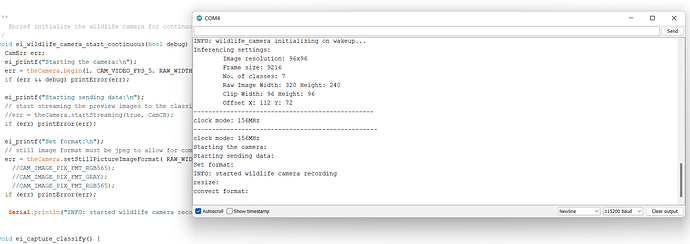So I think I have narrowed down the source of the unstableness. It has something to do with taking the image from the Video Preview, vs taking a Snapshot and running that through the classifier.
I am configuring both the Video preview and the Snapshot the same:
err = theCamera.begin(1, CAM_VIDEO_FPS_5, RAW_WIDTH, RAW_HEIGHT,CAM_IMAGE_PIX_FMT_YUV422);
err = theCamera.setStillPictureImageFormat( RAW_WIDTH,RAW_HEIGHT, CAM_IMAGE_PIX_FMT_YUV422);
With a static scene, here are the classification results when the Video Preview source is being used:
INFO: wildlife_camera initializing on wakeup...
Inferencing settings:
Image resolution: 160x160
Frame size: 25600
No. of classes: 2
Raw Image Width: 320 Height: 240
Clip Width: 160 Height: 160
Offset X: 80 Y: 40
Starting the camera:
Starting sending data:
Set format:
INFO: started wildlife camera recording
INFO: new frame processing...
convert format:
classify picture:
Predictions (DSP: 21 ms., Classification: 4319 ms., Anomaly: 0 ms.):
background: 0.035156
lego: 0.964844
INFO: new frame processing...
convert format:
classify picture:
Predictions (DSP: 21 ms., Classification: 4319 ms., Anomaly: 0 ms.):
background: 0.367188
lego: 0.632812
INFO: new frame processing...
convert format:
classify picture:
Predictions (DSP: 21 ms., Classification: 4319 ms., Anomaly: 0 ms.):
background: 0.593750
lego: 0.406250
INFO: new frame processing...
convert format:
classify picture:
Predictions (DSP: 21 ms., Classification: 4319 ms., Anomaly: 0 ms.):
background: 0.476562
lego: 0.523437
INFO: new frame processing...
convert format:
classify picture:
Predictions (DSP: 21 ms., Classification: 4319 ms., Anomaly: 0 ms.):
background: 0.351563
lego: 0.648437
INFO: new frame processing...
convert format:
classify picture:
Predictions (DSP: 21 ms., Classification: 4319 ms., Anomaly: 0 ms.):
background: 0.324219
lego: 0.675781
and here is when it is using the image from takePicture(). There still is some variance, which is weird since it should be the exact same image each time, but it is only about 8%
INFO: wildlife_camera initializing on wakeup...
Inferencing settings:
Image resolution: 160x160
Frame size: 25600
No. of classes: 2
Raw Image Width: 320 Height: 240
Clip Width: 160 Height: 160
Offset X: 80 Y: 40
Starting the camera:
Starting sending data:
Set format:
INFO: started wildlife camera recording
resize:
convert format:
Predictions (DSP: 21 ms., Classification: 4319 ms., Anomaly: 0 ms.):
background: 0.078125
lego: 0.921875
resize:
convert format:
Predictions (DSP: 21 ms., Classification: 4319 ms., Anomaly: 0 ms.):
background: 0.132812
lego: 0.867187
resize:
convert format:
Predictions (DSP: 21 ms., Classification: 4319 ms., Anomaly: 0 ms.):
background: 0.105469
lego: 0.894531
resize:
convert format:
Predictions (DSP: 21 ms., Classification: 4319 ms., Anomaly: 0 ms.):
background: 0.035156
lego: 0.964844
resize:
convert format:
Predictions (DSP: 21 ms., Classification: 4319 ms., Anomaly: 0 ms.):
background: 0.078125
lego: 0.921875
resize:
convert format:
Predictions (DSP: 21 ms., Classification: 4319 ms., Anomaly: 0 ms.):
background: 0.050781
lego: 0.949219
resize:
convert format:
Predictions (DSP: 21 ms., Classification: 4319 ms., Anomaly: 0 ms.):
background: 0.066406
lego: 0.933594
resize:
convert format:
Predictions (DSP: 21 ms., Classification: 4319 ms., Anomaly: 0 ms.):
background: 0.105469
lego: 0.894531
Here is an update of my program: spresense-picture.ino · GitHub


